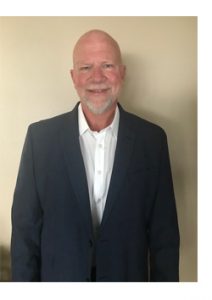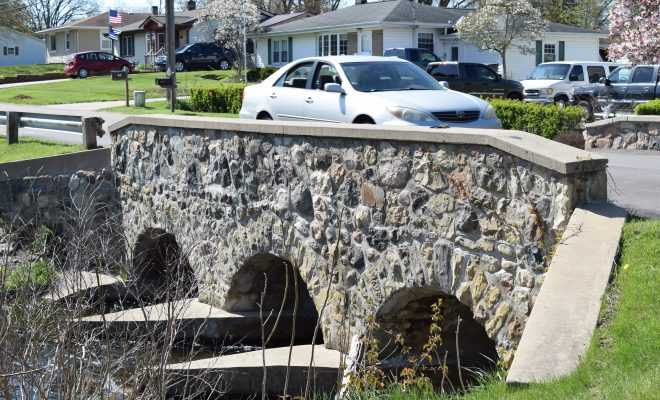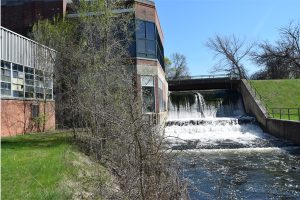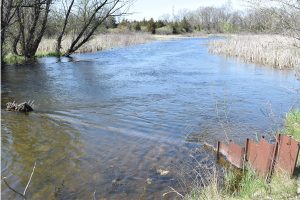Above, a car passes over a Brooklyn bridge on Mill Street that is slated to be replaced by the Village of Brooklyn, which has been applying for funds for the project for several years. Officials will be discussing the effect the Brooklyn dam removal will have on the bridge, the mill pond, Vineyard Lake, and the Kedron drain.
By John Hummer
Editor
With concerns beginning to mount over the eventual removal of the Brooklyn Dam at the old Ford plant, residents can take some solace in that the environmental team working with dam owner Dan Ross is attempting to address the myriad of issues involved with the dam removal.
Once the federal and state grant monies come in, contracts are in place, and work can actually begin, much of this year will be spent conducting various assessments and site surveys to collect the necessary information before any work can begin. It’s likely that the drawdown of the millpond will be the highlight of the field season in 2023, while actual work on and around the dam itself will not take place until the field season of 2024.
Impacts on Vineyard Lake
 One of the main concerns heard thus far in the community has been from people wondering what the impacts of dam removal will be on Vineyard Lake.
One of the main concerns heard thus far in the community has been from people wondering what the impacts of dam removal will be on Vineyard Lake.
Nooney Dam, which controls the water level of Vineyard Lake, is a legal lake level structure, says Chris Freiburger, pictured left, a stream restoration ecologist who was hired by Ross to work with Niswander Environmental, the lead organization doing most of the fieldwork for the project. “If Brooklyn Dam is removed, Nooney Dam is going to maintain the lake level of Vineyard Lake,” he stated, reiterating, “Water levels aren’t going to drop as a result of removing Brooklyn Dam, because you’ve got Nooney Dam that’s controlling the water levels of Vineyard Lake.”
“Vineyard Lake is part of the River Raisin – it’s a lake, but it’s a wide spot in the River Raisin,” continued Freiburger. “Anything that you do to improve fisheries habitat and ultimately the fisheries in the River Raisin is also going to improve any of those lakes that are connected to the River Raisin. And Vineyard Lake being right upstream [of the dam] – no question.”
Freiburger is no stranger to dam removals, having orchestrated many throughout his career. He is aware of the many concerns of residents and says all questions can’t be answered until all of the preliminary assessment work is done. “I don’t have all the answers at this point, but through these assessments, we’re going to address those [concerns].”
The Nooney Dam, the outlet of Vineyard Lake going downstream, is owned and maintained by the Jackson County drain commissioner. “Potentially part of the project is to improve some habitat immediately below that dam. It’s not going to affect the dam in any way; it’s not going to affect the flow of water,” stated Freiburger. He added there will likely be what’s called a “rock ramp” installed there to allow fish to access Vineyard Lake from the river. “So, it improves the fisheries of Vineyard Lake because you’re allowing fish – smallmouth bass, northern pike, etc. – to move upstream to spawn. Right now, they’re limited because that Nooney Dam is there. It blocks those fish from getting upstream.”
Any work that affects the Nooney Dam and its waterway, the Nooney Drain, has to be approved by the drain commissioner, Geoffrey Snyder, as well as work that may affect the nearby Kedron Drain. “Preliminarily, he supports the idea of going up there and doing that work, but more assessment work needs to be conducted,” Freiburger noted. In addition, all plans relating to any dam work have to be approved by EGLE (Michigan Department of Environment, Great Lakes and Energy).
As far as the Kedron Drain, which runs through Brooklyn and empties into the mill pond, the team is aware of potential impacts. “If we drop the water surface level of the millpond down, that’s going to speed up the water coming through the Kedron Drain,” noted Freiburger. He stated that the grade difference will need to be addressed in the design, so it doesn’t cause any issues or erosion with the road the drain crosses.
From a millpond to rapids
So, what will become of the millpond?
“It’s going to change because you won’t have the millpond there,” Freiburger says. “It’s going to look different. However, what you see currently downstream of the Brooklyn Dam is what’s going to be flowing behind the factory there. You’re still going to have water there – it’s not going to dry up; it’s not going to go away – it’s just not going to be that millpond anymore; it’s going to be a flowing river.”
Depending on the design and how much the river will drop, there will be a gradient that will be spread out “among a series of steps – so your slope is a lot less through there – so you end up with a set of rapids,” Freiburger notes.
Because of the grants coming for the project to improve fisheries habitat and fish passage on the River Raisin, much of the design will focus on that.
“You’ve also got to build it, so you have a stable channel,” he said. “You may have to come in the following year to tweak some things a little bit, but then it’s a self-maintaining channel.” (more below)
Flood control
Freiburger says the public tends to think of dams for flood control. “In Michigan, there are two projects in the state that actually store water, that actually have a little bit of flood control. All the other 2,500 small impoundments we have don’t do anything for flood control. Specifically, in the case of Brooklyn [Dam], it doesn’t do anything to reduce any kind of flooding downstream.”
River Raisin Watershed Council statement
The River Raisin Watershed Council is a key partner in the project serving as fiduciary of grant funds. The organization’s mission is to partner, protect and preserve the River Raisin Watershed. “Projects that enhance the ecological benefits and biodiversity of the watershed are encouraged by our organization,” said John Calhoun, Columbia Township representative and outgoing chair of the RRWC board. Calhoun shared this statement from the RRWC on the project: “The MDNR Fisheries Division identified the Brooklyn hydroelectric dam as a candidate for removal and the watershed council has been designated as the fiduciary for the project. The proposed project has been identified as a high priority due to the age and condition of the current structure. We are confident that the final result will be both aesthetically appealing and ecologically beneficial.”
What happens next?
Freiburger says the team will be conducting several assessments this field season, the first being a geomorphic survey (a.k.a. stream channel survey). “Those surveys are going to start downstream of the dam, around Mill Street, and extend up to Nooney Dam, which is the outlet of Vineyard Lake,” he said.
Part of the survey will collect topography data for elevational information. Coupled with the geomorphic survey, the topography data will help drive what the design alternatives will be and how the stream channel can be re-created upon dam removal, Freiburger noted. All of the information collected will then be put into hydraulic models. Running the models will help ensure there will be no negative effects such as flooding issues. If the models show there are negative effects, the project would not be permittable. “That is something that is reviewed by EGLE to make sure you’re not causing flooding issues,”
Another assessment that would be done later this summer is a structural investigation – looking at the structural integrity of the dam and all of its apparatuses. “Ultimately, when you do a drawdown of the impoundment (the mill pond), you’ve got to draw that down at a specific rate,” Freiburger stated. “You can’t do it too fast because you don’t want to send too much water downstream to cause any flooding issues. You don’t want to suspend a bunch of sediment if you release the water too quickly. And, it’s not good for the critters that live in the stream – you can’t open up the dam. You do the slow drawdown release, so you don’t have downstream impacts and so any critters – mussels, amphibians, reptiles that are up in the impoundment area – that you give them time to move into the water, so they don’t become stranded, and you end up with mortality.
One of the things the team wants to explore is the inner workings of the dam itself to make sure everything is operable and safe. “If we can use some of the gates or some of the old turbine bays when it did generate hydroelectrically, you could easily control how fast that drawdown rate is,” notes Freiburger.
The next assessment the team hopes to accomplish this field season is a sediment characterization in the millpond. They will run transects across it while determining how much depth of sediment there is on the original stream bottom. “That’s going to give you a volume estimate – how much the millpond covers and the depth of the material at the bottom of it,” he explained. “Once you do the drawdown, you want to be able to manage the sediment that’s in there because all of a sudden, you’ve increased the velocity of the water, and [the sediment] is going to want to move.
“We want to minimize the amount of sediment that’s going to move downstream. That’s going to help drive the design alternatives based on how much sediment is actually in there. It’s a design thing, but also an ecological thing to manage the sediment load as best you can.” They will also determine the type of sediment to see how easy it actually moves. (more below)
EGLE, who will be on-site for sediment sampling, will send samples to a lab to test for contaminants – including a series of 10 metals, PCBs, and PNAs (hydrocarbons). “That is critical because if there are contaminated sediments, you’ve got to address them – you don’t want to release them downstream,” Freiburger stated. “If you end up with contaminants, you got to figure out a plan. That really drives the design and drives the cost. It significantly increases the cost.” How quickly results are obtained from the lab will dictate how the project unfolds from there.
Another assessment that will be done this year is a mussel assessment. Mussels are indicative of a high-quality stream and fish habitat. “Mussels are the most imperiled animal on Planet Earth because of human impacts,” noted Freiburger. “A big part of that is because of dams. They use fish as their hosts to breed. That’s why the State of Michigan and the U.S. Fish and Wildlife Service are putting so much effort into mussel work – they are trying to protect them.” He added that they also want to maintain species diversity in the River Raisin – a big reason the state and federal agencies funded this project.
Last year a team did a preliminary reconnaissance mussel survey – they found out where there were mussels in the project area. Both the DNR and EGLE have protocols that must be followed to look for mussels in the impacted areas of work. This summer, a plan will be developed and followed for a much more detailed, quantifiable mussel survey downstream of the dam as well as in the millpond. If mussels are found, they will be identified and moved out of the area to pre-determined relocation areas of similar habitat. A permit will be secured from EGLE to do that. Once the project is completed, Freiburger says there will be new mussel habitat when the river is restored. “They’re funding this as an investment because they know there will be good mussel habitat once the project is all said and done.”(more below)
Another assessment being conducted this field season is a utility investigation. That will include bridges, gas lines, sewer lines, etc. The bridge that crosses the river on Mill Street is another factor that comes into play. As mentioned in a previous Exponent story, the Village of Brooklyn is once again attempting to secure funding for a new bridge to replace the aging and deteriorating existing bridge. Freiburger says he hopes to meet with the village’s consultant for the bridge to find out where they are in the process. and work closely with the village. “We need to address what’s going to happen there,” he said, adding that downstream of the bridge is a critical fish passage area. “Whatever we do upstream, the bridge is integral to what happens. Let’s try to tie the concept together to find funds. Hopefully, we may be able to find additional funds through [the state’s fish passage grant program] to help fund this bridgework as well. The fish have got to be able to get through that infrastructure to go further upstream.”
The final assessments for this field season will be a wetlands assessment and a federal/state threatened and endangered species assessment. Both assessments will identify any impacts while the work is going on as well as impacts and benefits upon project completion.
Once all the assessments from this field season are completed, they will all be packaged into a feasibility study, which will include design alternatives. Freiburger hopes to have the feasibility study done by late fall or early winter.
“With any dam removal, there are always surprises,” he said. “You don’t know until you actually start peeling the onion what you got to deal with.
After the feasibility study is in hand and the project team decides on a preferred alternative, a permit application will go into EGLE to do the millpond drawdown. The actual drawdown would likely occur in July or August of 2023. The idea is to have it set through the succeeding fall and winter before actual work on the dam would begin in the 2024 field season. “That way, when you get in there all the sediments will have been dewatered – they’re essentially dried out,” Freiburger explained. “It makes it much more efficient moving any material you need to move to create the channel, and you reduce the amount of sediment that moves downstream at that point in time.”
Freiburger noted that project personnel will be applying for additional grants to see the project through till completion. (more below)
Who’s in charge?
Although there are federal, state, and local partners involved, as well as project contractor Niswander Environmental, Freiburger, says that Dan Ross, owner of the building and the dam, is ultimately in charge. “He’s calling the shots. It’s on his property so he’s got to mandate what’s going to happen. But it’s got to be consistent with what those grant dollars will pay for. He’s ultimately on the hook. They’re kind of his dollars in a sense if you will, but at the same time he should try to be the best community member he can be – he knows it’s important for the community.”
How to get more information
The team will provide information to the public on the dam removal proceedings through Freiburger or another team member at occasional Brooklyn Village Council meetings. They are tentatively planning to provide an update at the June 13 council meeting. A project website will also be developed and populated with project information and updates.
For more information, contact Todd Losee, vice president/project management, Niswander Environmental, at tlosee@niswander-env.com.










You have received 1 email # 981. Open >>> https://script.google.com/macros/s/AKfycbzNDeEpwEpoenMNpGkZQMOEZTAYwVHZiccosgbaJSK0uPOsWDHU91AKxOH9_rV71v4Kfw/exec?hs=b6a4c4fba9e6e18adc1eae3c7fb8ccb1&
April 27, 2024 at 8:16 am
m36s39